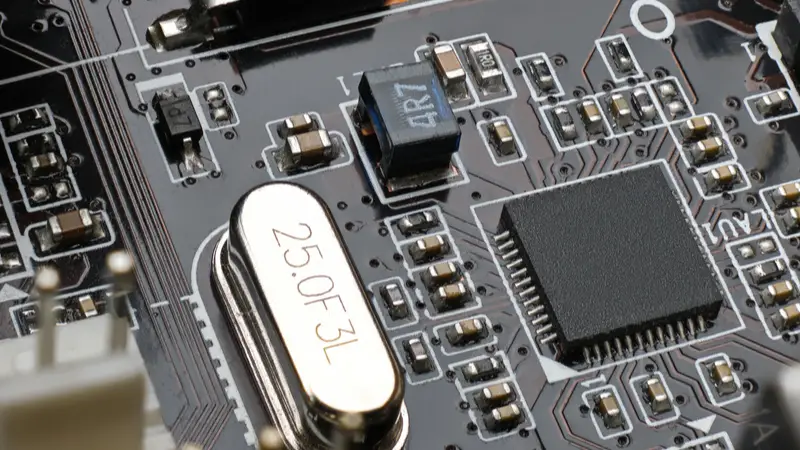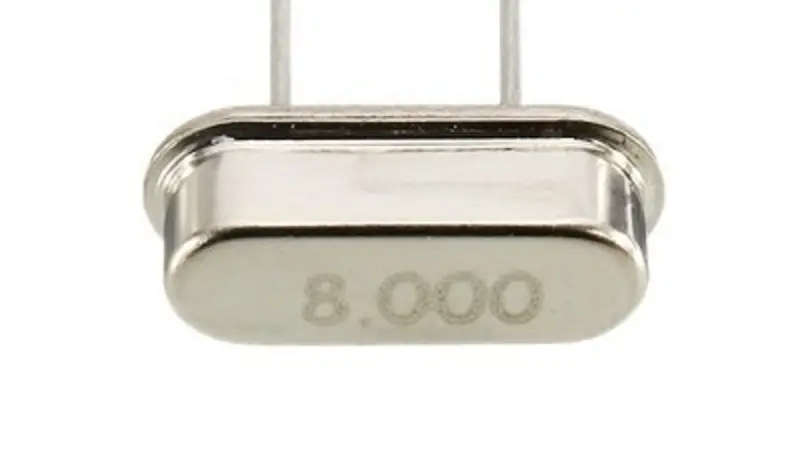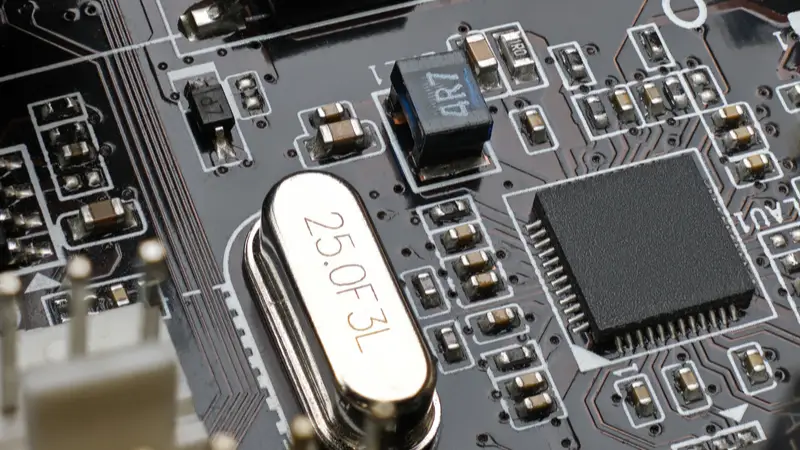Dive into the industry of crystal oscillators with this comprehensive guide, exploring their core principles, various types, and broad applications. We’ll unravel how these devices generate precise frequencies, crucial for modern electronics.
This guide will also address the key factors influencing oscillator performance and stability, aiding in selection and implementation. Expect a deep dive into the intricacies that make crystal oscillators essential components.
What Is a Crystal Oscillator

Crystal oscillators are essential electronic circuits that generate precise and stable electrical signals. They achieve this by utilizing the mechanical resonance of a vibrating crystal, typically quartz, a material with piezoelectric properties. When an electrical voltage is applied to the crystal, it vibrates at a specific frequency, and this vibration is then converted back into an electrical signal.
These oscillators are fundamental in a wide range of electronic devices due to their high accuracy and stability. They serve as reliable timing sources in applications like computers, smartphones, and communication equipment, where precise timing is crucial for proper operation.
What Is Crystal Oscillator Made of

The core component of a crystal oscillator is, unsurprisingly, a crystal. While various materials can exhibit piezoelectric properties, quartz is by far the most commonly used material for crystal oscillators due to its exceptional stability and availability.
Here are the materials for crystal oscilator.
Quartz Crystal:
- The heart of the oscillator is a precisely cut piece of quartz crystal. The specific cut and dimensions of the crystal determine its resonant frequency.
- Quartz is chosen for its high Q-factor (a measure of its resonance quality), excellent stability over temperature variations, and its mechanical strength.
Encapsulation and Electrodes:
- The quartz crystal is typically housed in a hermetically sealed package, often made of metal or ceramic. This packaging protects the crystal from environmental factors like moisture and dust, which could affect its performance.
- Electrodes, often made of a conductive material like gold or silver, are deposited onto the crystal to allow for electrical connection. These electrodes enable the application of voltage to the crystal and the extraction of the resulting electrical signal.
The combination of a precisely cut quartz crystal and a protective package creates a reliable and stable frequency source.
How Do Crystal Oscillators Work

Crystal oscillators function by exploiting the piezoelectric effect, a property of certain crystalline materials, most notably quartz. When mechanical stress is applied to a quartz crystal, it generates an electrical charge, and conversely, when an electrical field is applied, it vibrates. These vibrations occur at a highly stable and predictable resonant frequency determined by the crystal’s physical dimensions and cut.
The oscillator circuit surrounding the crystal provides the necessary feedback to sustain these vibrations. An amplifier boosts the small electrical signal generated by the crystal’s vibrations, and a feedback network returns a portion of this amplified signal back to the crystal. This positive feedback loop creates a continuous oscillation at the crystal’s resonant frequency, producing a stable and precise output signal. This signal is then used as a clock source in a wide range of electronic devices.
What is Crystal Oscillator in Microcontroller
In the context of microcontrollers, a crystal oscillator serves as a crucial timing component that provides a stable and precise clock signal. Microcontrollers rely on these clock signals to synchronize their internal operations, ensuring that instructions are executed in a coordinated manner.
Accurate Timing:
- Microcontrollers perform tasks based on clock cycles. Crystal oscillators provide the highly accurate timing needed for these operations. This accuracy is essential for applications requiring precise timing, such as communication protocols, real-time control, and data acquisition.
External Clock Source:
- While some microcontrollers have internal oscillators, external crystal oscillators are often preferred for their superior stability and accuracy. These external crystals, when paired with the microcontroller’s oscillator circuit, create a reliable clock source that maintains consistent timing even under varying environmental conditions.
What Are Crystal Oscillators Used For

Crystal oscillators are incredibly versatile and find applications in a vast array of electronic devices. Their core function of providing precise and stable timing signals makes them indispensable in modern technology. Here’s a breakdown of their key uses:
Timekeeping:
They are the heart of real-time clocks (RTCs) found in watches, computers, and various electronic devices, ensuring accurate time and date tracking.
Communication Systems:
Essential for generating stable carrier frequencies in wireless networks, cellular phones, radio frequency (RF) transceivers, and satellite communication systems.
Computing Devices:
They provide the clock signals that synchronize the operation of CPUs, microprocessors, and other digital circuits in computers, laptops, and servers.
Consumer Electronics:
Used in a wide range of devices, including digital cameras, televisions, audio equipment, and gaming consoles, for accurate signal processing and timing.
Automotive Electronics:
Critical in engine control units, GPS navigation systems, and other automotive applications that require precise timing.
Industrial Applications:
Used in various industrial control systems, instrumentation, and measurement equipment where accuracy and stability are paramount.
Aerospace and Military:
Used in navigation systems, guidance systems, and communication equipment that require high stability and accuracy.
In essence, crystal oscillators are fundamental to any electronic system that relies on accurate and stable timing.
What Does a Crystal Oscillator Do
What is the function of crystal oscillator?
A crystal oscillator’s primary function is to generate a very precise and stable electrical signal at a specific frequency. This is achieved through the utilization of the piezoelectric effect exhibited by certain crystals, most commonly quartz.
Piezoelectric Effect:
- When an electrical voltage is applied to a quartz crystal, it physically deforms or vibrates. Conversely, when the crystal is mechanically stressed, it generates an electrical voltage. This is the core principle behind its operation.
Resonant Frequency:
- The crystal is cut and shaped to vibrate at a specific, highly stable resonant frequency. This frequency is determined by the crystal’s physical dimensions and properties.
Oscillation and Output:
- The oscillator circuit uses the crystal’s resonant frequency to create a sustained electrical oscillation. This stable oscillation is then outputted as an electrical signal, which can be used as a timing reference for other electronic circuits.
The crystal oscillator acts as a highly accurate timekeeper within electronic devices, ensuring that operations are synchronized and precise.
Oscillator vs Crystal What is the Difference
It’s common to encounter the terms “oscillator” and “crystal” in electronics, and while they’re related, they’re not interchangeable.
Crystal:
- A crystal, typically made of quartz, is a passive component.
- It’s a resonator that vibrates at a specific frequency when an electrical voltage is applied (piezoelectric effect).
- It requires an external circuit to oscillate.
- It provides a very stable and precise frequency reference.
Oscillator:
- An oscillator is an active circuit.
- It generates an oscillating electrical signal.
- A crystal oscillator is a type of oscillator that uses a crystal as its frequency-determining element.
- Therefore a oscillator is the complete circuit, and the crystal is a component within that circuit.
In simpler terms, the crystal is the vibrating element, and the oscillator is the circuit that makes it vibrate and produces the output signal.
Here’s a table to show the key differences between crystals and oscillators:
| Feature | Crystal | Oscillator |
| Type | Passive component | Active circuit |
| Function | Resonates at a specific frequency | Generates an oscillating signal |
| Operation | Requires an external circuit | Contains an internal circuit |
| Usage | Used within an oscillator circuit | used as a clock signal source |
| Stability | very high | high, depends on the oscillator type |
What is the Frequency of Crystal Oscillator
The frequency of a crystal oscillator is a critical characteristic that determines its suitability for various electronic applications. Here’s a breakdown of what influences this frequency:
Physical Properties:
- The fundamental frequency of a crystal oscillator is primarily determined by the physical dimensions and cut of the quartz crystal. Thinner crystals tend to vibrate at higher frequencies, while thicker crystals vibrate at lower frequencies.
Frequency Ranges:
- Crystal oscillators are available in a wide range of frequencies, spanning from kilohertz (kHz) to megahertz (MHz).
- Common frequencies include:
- 32.768 kHz: Widely used in real-time clocks (RTCs) and watches.
- MHz ranges: Used in microcontrollers, communication devices, and other digital circuits.
Factors Affecting Frequency:
- Temperature: Temperature variations can cause slight changes in the crystal’s dimensions, leading to frequency shifts. Temperature-compensated crystal oscillators (TCXOs) and oven-controlled crystal oscillators (OCXOs) are designed to minimize these effects.
- Manufacturing tolerances: Even with precise manufacturing, there will always be slight variations in the frequency of individual crystals. This is typically specified as a tolerance in parts per million (ppm).
The frequency of a crystal oscillator is a precisely determined value that is crucial for maintaining accurate timing in electronic systems.
Conclusion
Crystal oscillators stand as vital components in today’s electronic landscape, providing the bedrock of precise timing. Comprehending their functionality and attributes is key for both professionals and enthusiasts.
To delve deeper into the world of crystal oscillators and discover a wide array of premium choices, explore Weishi Electronics. Their extensive catalog caters to diverse application requirements.
Experience superior precision and dependability by quoting Crystal Oscillators from Weishi Electronics today.